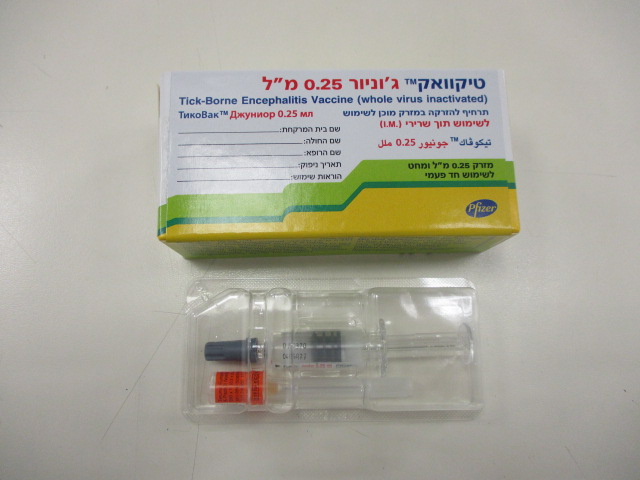Quest for the right Drug

טיקוואק ג'וניור 0.25 מ"ל TICOVAC JUNIOR 0.25 ML (ENCEPHALITIS, TICK BORNE, INACTIVATED, WHOLE VIRUS)
תרופה במרשם
תרופה בסל
נרקוטיקה
ציטוטוקסיקה
צורת מתן:
תוך-שרירי : I.M
צורת מינון:
תרחיף להזרקה : SUSPENSION FOR INJECTION
עלון לרופא
מינוניםPosology התוויות
Indications תופעות לוואי
Adverse reactions התוויות נגד
Contraindications אינטראקציות
Interactions מינון יתר
Overdose הריון/הנקה
Pregnancy & Lactation אוכלוסיות מיוחדות
Special populations תכונות פרמקולוגיות
Pharmacological properties מידע רוקחי
Pharmaceutical particulars אזהרת שימוש
Special Warning עלון לרופא
Physicians Leaflet
Posology : מינונים
4.2 Posology and method of administration Posology Primary vaccination schedule The primary vaccination schedule is the same for all persons from 1 year to 15 years of age and consists of three doses of TicoVac Junior 0.25 ml. The first and second dose should be given at a 1 to 3 month interval. If there is a need to achieve an immune response rapidly, the second dose may be given two weeks after the first dose. After the first two doses a sufficient protection for the ongoing tick season is to be expected (see section 5.1). The third dose should be given 5 to 12 months after the second vaccination. After the third dose protection is expected to last for at least 3 years. To achieve immunity before the beginning of the seasonal tick activity, which is in spring, the first and second doses should preferably be given in the winter months. The vaccination schedule should ideally be completed 2023-0088615 Page 1 of 8 with the third vaccination within the same tick season or at the least before the start of the following tick season. Basic Immunization Dose Conventional Schedule Rapid Immunization Schedule st 1 dose 0.25 ml Elected date Elected date 2nd dose 0.25 ml 1 to 3 months after the 1st vaccination 14 days after the 1st vaccination 3rd dose 0.25 ml 5 to 12 months after the 2nd vaccination 5 to 12 months after the 2nd vaccination Booster doses The first booster dose should be given 3 years after the third dose (see section 5.1). Sequential booster doses should be given every 5 years after the last booster dose. Booster dose Dose Timing 1st booster 0.25 ml 3 years after the 3rd vaccination Sequential booster doses 0.25 ml every 5 years Extending the interval between any of the doses (primary vaccination schedule and booster doses) may leave subjects with inadequate protection against infection (see section 5.1). However, in the case of an interrupted vaccination schedule of at least two previous vaccinations, a single catch-up dose is sufficient to continue the vaccination schedule (see section 5.1). No data regarding catch-up dose in children less than 6 years of age are available (see section 5.1). Children with an impaired immune system (including those undergoing immunosuppressive therapy) There are no specific clinical data on which to base dose recommendations. However, consideration may be given to determining the antibody concentration at four weeks after the second dose and administering an additional dose if there is no evidence of seroconversion at this time. The same applies to any of the following doses. Method of administration The vaccine should be given by intramuscular injection into the upper arm (deltoid muscle). In children up to 18 months of age, or dependent on a child’s development and nutrition status, the vaccine is administered into the thigh muscle (vastus lateralis muscle). In exceptional cases only (in subjects with a bleeding disorder or in subjects receiving prophylactic anticoagulation), the vaccine may be administered subcutaneously (see sections 4.4 and 4.8). Care must be taken to avoid accidental intravascular administration (see section 4.4).

שימוש לפי פנקס קופ''ח כללית 1994
לא צוין
תאריך הכללה מקורי בסל
לא צוין
הגבלות
לא צוין
מידע נוסף
